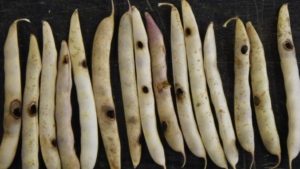Trap counts are still quite high this week in Ontario which indicates that peak flight hasn’t plateaued yet. So there is likely still lots of egg laying happening. Moths will prefer to lay eggs in later planted corn that is still in pre to early tassel stages or will find dry bean fields nearby. Just because a trap is catching a lot of moths, does not mean that field has reached threshold. It means you should scout that field and any other field in the area that is in the ideal growth stages.

We experienced WBC damage in dry beans in Ontario for the first time in 2014. More attention should be spent on scouting that crop this year, given that moth flights have been significant once again. For dry beans, it is highly unlikely that you will find eggs or larvae no matter how diligent you are at scouting. In dry beans, the larvae are active at night and hide in the soil during the day. You are much better off spending your time looking for the first signs of feeding holes in the pods. Pod feeding is expected to start approximately 10 to 20 days after peak flight. Effective control can still occur then, as long as pod feeding is spotted early and dealt with.
Dry bean fields planted on sandy soils and in areas of known hot spots (Thamesville to Strathroy and Tillsonburg/Simcoe) are at higher risk. Field bordering corn fields that have reached threshold are also at risk, especially once corn is beyond the pre-tassel stages.
Action Threshold for Dry Beans: If WBC has reached a threshold in the neighbouring corn field, adjacent dry bean fields are likely at risk, especially if the corn fields have passed the pre-tassel stage and moths are still actively flying, as indicated by the pheromone traps. If entry holes are observed in the pods, an insecticide application is necessary.
Since WBC exit and enter new pods each night, foliar insecticides can still work at controlling the larvae. Select insecticides that have some residual and pay attention to pre-harvest intervals. Recommended insecticide options are available here: Foliar Insecticides Registered for Western Bean Cutworm Control on Dry Edible Beans in Canada. Spot treatments may be effective if injury is concentrated to one area of the field.